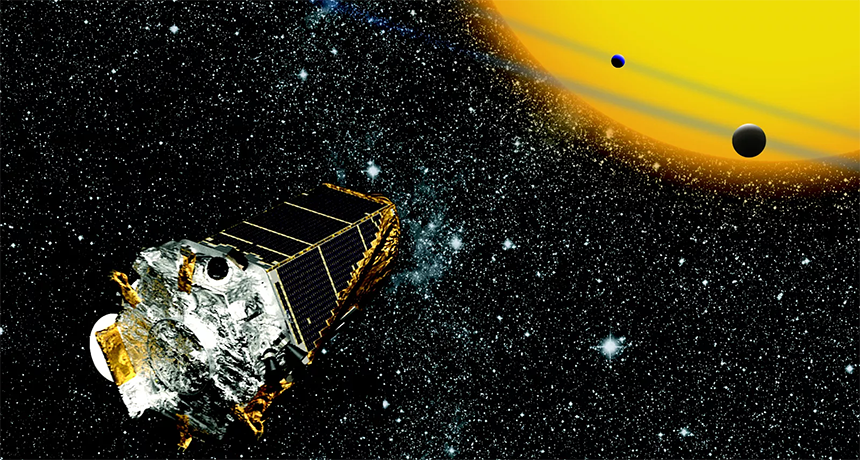Kepler telescope can’t be fixed
It had been NASA’s top planet-hunting telescope

This drawing depicts the Kepler space telescope in space. Two of its four reaction wheels have failed and NASA can’t repair them.
NASA
By Andrew Grant
Since its launch on March 6, 2009, the $600 million Kepler space telescope has been hunting for planets outside Earth’s solar system. And to date, it’s turned up thousands. But in July 2012, the National Aeronautics and Space Administration announced that one important part on the spacecraft had failed. In May of this year, a sister part failed. NASA initially hoped it might fix the broken parts. No more. On August 15, space-agency officials announced that Kepler’s damage was beyond repair.
The spacecraft relies on four “reaction wheels” to help turn the telescope toward the stars that scientists want to target. Two of those reaction wheels no longer work correctly. By losing the ability to precisely point the spacecraft toward targeted stars, the telescope can no longer detect the small dips in starlight that signify the existence of distant planets.
Last month, engineers forced each of the faulty wheels back into action, one at a time. But as each spun, it encountered unexpectedly high friction. This resistance to spin is a death sentence for telescopes that rely on reaction wheels.
Earlier this month, engineers tried to direct the telescope using the remaining two healthy wheels and the better of its two troubled ones. All seemed to work fine for about six hours. But then the telescope automatically turned itself off. The reason: The faulty wheel again had encountered too much friction.
“The wheels are sufficiently damaged that they cannot sustain spacecraft pointing control” — at least not for long, reported Charles Sobeck in a telephone briefing for reporters. He’s Kepler’s deputy project manager and works at the NASA Ames Research Center in northern California.
The good news: The spacecraft is not dead. In fact, Kepler scientists are now exploring what the telescope might be able to do with just its two undamaged reaction wheels. NASA had planned to spend roughly $18 million on Kepler experiments this year. Soon, the space agency will decide whether to go ahead and spend all or part of that money for a reduced mission. It will, however, be a tough sell: Kepler’s precision focus is what made it an unprecedented scientific asset.
Prior to the Kepler mission, astronomers had identified an estimated 350 exoplanets — planets beyond the solar system. In just four years, the Kepler telescope found over 3,000 more.
Those numbers boosted the case for funding NASA’s next exoplanet-hunting mission. Called the Transiting Exoplanet Survey Satellite, or TESS, it’s scheduled for a 2017 launch. Unlike Kepler, which fixed its gaze on distant stars, TESS will focus on bright, nearby stars. If TESS finds planets around them, powerful telescopes like the upcoming James Webb Space Telescope will be able to probe their atmospheres.
The $200-million telescope on TESS will not be as sensitive as Kepler’s is. Still, the Kepler telescope was so successful at finding exoplanets that TESS scientists are hopeful theirs will uncover plenty of planets in our neighborhood, including a handful of Earth-sized worlds.







